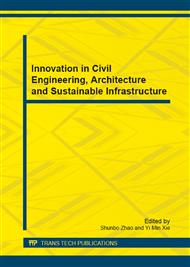p.26
p.33
p.37
p.41
p.46
p.51
p.57
p.61
p.66
Study on Damage Evolution Mechanism of Concrete under Uniaxial Tension
Abstract:
The damage and failure mechanism of quasi-brittle materials is the most fundamental research topic in Damage Mechanics. In this paper, the mesoscopic damage mechanism of concrete under uniaxial tension was discussed. The rupture and yield damage modes in meso-scale were introduced as the two basic parameters to define the damage accumulated variable. The results show that the proposed statistical damage model can accurately predict the whole deformation and failure process of concrete under uniaxial tension, including the two-stage deformation characteristics and the size effect.
Info:
Periodical:
Pages:
46-50
Citation:
Online since:
November 2012
Authors:
Price:
Сopyright:
© 2012 Trans Tech Publications Ltd. All Rights Reserved
Share:
Citation:


